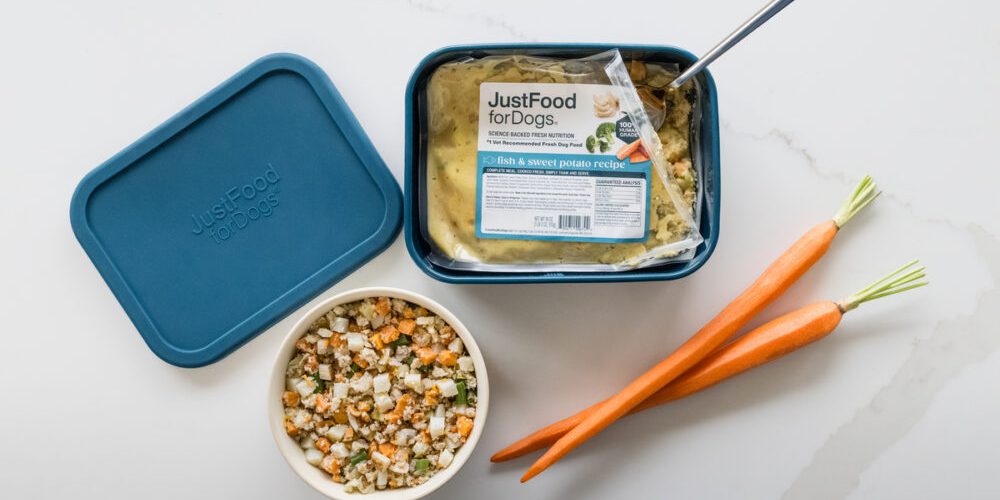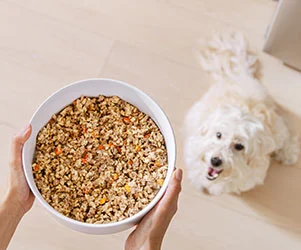Friendly, affectionate, and adorable, “doodles,” including the goldendoodle, labradoodle, and bernedoodle, have become highly sought-after mixed breeds. Doodles, or poodle mixes, combine the intelligence and low-shedding coat of the poodle with the laid-back personality of other purebred dogs like the golden retriever, Labrador retriever, and Bernese mountain dog.
Doodles draw a family-friendly following because many are hypoallergenic, and most are great with kids. There’s plenty to love about these high-energy crossbreeds.
Still, pet parents must understand that doodles, like other purebred and designer dogs, can suffer from health problems inherited from their parent breeds.
Here are the common health issues doodles face and how nutrition and preventive care can support lifelong pet health for any breed.
Common doodle health issues

Doodles are mixed breeds, meaning they can suffer from health issues common to either of their parent breeds. Mixing dog breeds widens the gene pool, which can reduce the risk of harmful genetic conditions, but doesn’t eliminate the risk.
Here’s an overview of common health issues seen in poodle mixes.
1. Hip and elbow dysplasia
Doodles, especially larger varieties, are at risk for orthopedic conditions like hip dysplasia and elbow dysplasia. These developmental conditions occur when the bones in the joint don’t form correctly as the dog grows. The abnormal joint shape puts excessive forces on the bones during everyday motion.
Over time, abnormal joint movements lead to inflammation, reduced mobility, and painful arthritis. Affected dogs may suffer from limping, difficulty rising, or reluctance to jump or climb stairs. Symptoms can begin at a young age but may not appear or worsen until dogs get older, become overweight, or increase activity.
2. Progressive retinal atrophy (PRA)
Progressive retinal atrophy (PRA) is a degenerative disease that causes gradual vision loss and eventual blindness. It affects the retina, the area on the back of the eye that detects light and helps send images to the brain.
Poodles, golden retrievers, and Labradors can carry PRA genes, some of which are detectable through genetic testing. PRA has no cure, but it is not painful, and early detection can help affected pets and pet parents adapt to progressive vision loss.
3. Addison’s disease
Addison’s disease (i.e., hypoadrenocorticism) affects the adrenal glands, which produce important hormones, such as cortisol to manage stress and aldosterone to maintain normal fluid balance. The disease impairs the production of these hormones, leaving the body unable to handle normal everyday functions.
Addison’s is known as “the great imitator” because early signs mimic other health problems. Fatigue, vomiting, and poor appetite are common. Left untreated, severe cases of Addison’s cause life-threatening shock.
Standard poodles and Labrador retrievers are prone to this condition, which means doodles are also at risk.
4. Von Willebrand’s disease
This inherited bleeding disorder prevents blood from clotting properly. Dogs with Von Willebrand’s disease may bruise easily or experience prolonged bleeding from minor cuts or during surgery. While not always evident in day-to-day life, the disorder can become serious or life-threatening during emergencies.
Standard poodles and Bernese mountain dogs are at risk for Von Willebrand’s disease, although a DNA test is available to help reduce the incidence in responsibly bred doodle puppies.
5. Hypothyroidism
Hypothyroidism occurs when the thyroid gland fails to produce enough thyroid hormones to maintain normal metabolism in dogs. Symptoms include weight gain, low energy levels, increased or decreased appetite, a thinning coat, cold intolerance, and chronic skin infections.
This condition is prevalent in golden retrievers, putting golden mixes at risk as well. Hypothyroidism is manageable with daily medication, but it can be difficult to diagnose definitively and requires regular blood work to monitor.
6. Allergies and ear infections
Retrievers are prone to environmental allergies, which can cause chronic skin and ear infections. Doodles with floppy ears are most at risk due to trapped heat and moisture in the ear canal, which can allow fungi or bacteria to grow. In poodles, the curly, dense coat can also grow inside the ear canals, worsening the problem.
Ear infection symptoms include head shaking, scratching, redness, and an unpleasant odor.
Regular grooming, ear cleansing, and proper drying after baths or swimming are essential prevention strategies. Doodle owners who notice red, irritated, or crusty skin lesions on their dogs should head to the vet for an allergy evaluation.
7. Gastric dilatation-volvulus
Gastric dilatation-volvulus (GDV), also known as bloat, is a life-threatening condition in which the stomach fills with gas and may twist on itself. The twisting can cut off blood flow to the stomach and other organs, causing pain and requiring emergency surgery.
Doodles with standard poodle lineage are at increased risk due to their deep chests. Early signs of GDV include:
- restlessness
- pacing
- drooling
- a distended abdomen
- repeated attempts to vomit without bringing anything up
If your dog is high-risk, your vet may recommend a preventive procedure called a gastropexy to tack the stomach in place.
Preventing common health issues in doodles

While you can’t change your dog’s genetics, you can proactively protect your doodle from many health concerns. Here’s how to help your doodle stay healthy:
Choose a reputable breeder
A reputable breeder will perform comprehensive health testing on parent dogs, screening for PRA, hip dysplasia, Von Willebrand’s disease, and other genetic disorders whenever possible. However, even puppies from healthy parents can develop health problems. Choose a breeder who follows the health of their puppies after they go to new homes so they can improve their dogs’ health over time. Better yet… adopt!
Feed your doodle mindfully
Nutrition is a powerful tool for preventing and managing health conditions in large-breed dogs and smaller poodle mixes. A fresh, whole-food, balanced diet designed for each dog’s life stage may support joint, immune, skin, eye, and digestive health.
Follow your veterinarian’s recommendations when choosing a diet and supplements that meet your pet’s needs. Depending on your doodle’s medical history, consider the benefits of omega-3 fatty acids, glucosamine, or probiotics for overall well-being.
Consider a slow-feeder or puzzle bowl to slow food intake at mealtimes. Avoid activity immediately after eating to reduce the chances of GDV.
Provide regular exercise
Being overweight can increase the severity of many doodle health issues. Regular exercise can ensure a healthy weight and give your pup an outlet for excess mental and physical energy. Many doodles enjoy swimming, walking, or dog sports.
Prioritize regular grooming
Routine grooming keeps your pup looking fresh and helps to prevent or detect skin issues, ear infections, and painful matting. Doodle coat types can vary from dog to dog, so be sure to ask your groomer about the best tools to use at home.
Keep your doodle’s ears clean and dry, and brush them frequently to remove tangles. Professional grooming may be required periodically.
Schedule routine vet visits and check-ups
Routine check-ups are essential to catch developing health issues early. Your veterinarian may suggest blood work with thyroid testing, orthopedic screening exams, or eye tests based on your dog’s breed mix.
Early detection often means more treatment options and a better chance at managing conditions before they become advanced or life-threatening.

Responsible doodle ownership
It’s easy to fall in love with a doodle. Whether you have a fluffy goldendoodle, water-loving labradoodle, or mellow bernedoodle, these popular designer dog breeds offer charm, intelligence, and companionship for any family.
As a crossbreed, your doodle may inherit traits and health conditions from both sides of their family tree. But with proper nutrition, consistent preventive care, and a little know-how, you can help your dog stay healthy over their lifetime.
For the best doodle nutrition, learn what fresh, science-backed meals from JustFoodForDogs can do to support long-term health and overall wellness.
Sources
Dockweiler, Jenna, and Aly Cohen. 2022. “Progressive Retinal Atrophy.” Cornell University College of Veterinary Medicine. September 9, 2022. https://www.vet.cornell.edu/departments-centers-and-institutes/riney-canine-health-center/canine-health-information/progressive-retinal-atrophy.
Cohen, Aly. 2022. “Addison’s Disease.” Cornell University College of Veterinary Medicine. November 4, 2022. https://www.vet.cornell.edu/departments-centers-and-institutes/riney-canine-health-center/canine-health-information/addisons-disease.
“Disorders of the Thyroid Gland in Dogs – Dog Owners.” n.d. Merck Veterinary Manual. https://www.merckvetmanual.com/dog-owners/hormonal-disorders-of-dogs/disorders-of-the-thyroid-gland-in-dogs.
“Allergies in Dogs – Dog Owners.” n.d. Merck Veterinary Manual. https://www.merckvetmanual.com/dog-owners/skin-disorders-of-dogs/allergies-in-dogs.
Bell, Jerold S. 2014. “Inherited and Predisposing Factors in the Development of Gastric Dilatation Volvulus in Dogs.” Topics in Companion Animal Medicine 29 (3): 60–63. https://doi.org/10.1053/j.tcam.2014.09.002.
This content is for informational use only and does not replace professional nutrition and/or medical advice, diagnosis, or treatment. It is not a substitute for and should not be relied upon for specific nutrition and/or medical recommendations. Please talk with your veterinarian about any questions or concerns.






